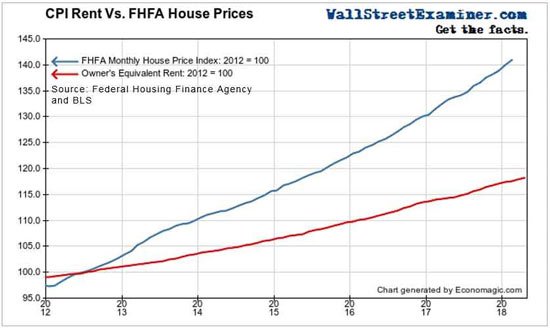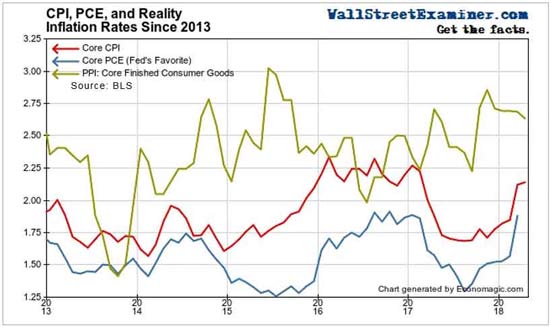Even by the deeply flawed and misleading Consumer Price Index (CPI), inflation is at the U.S. Federal Reserve's target. By other measures that more accurately portray inflation, it is well above target.
The Fed will not be deterred from continuing to tighten, continuing to remove money from the system, just because of the silliness that "CPI missed expectations."
It's still at least 2%... and it's heating up.
Furthermore, we know beyond a shadow of a doubt that, as the Fed raises the federal funds rate target, it will only stimulate more inflation. The Fed will always be behind the curve, because the Fed is always back there pushing the curve ahead.
Every time it raises the federal funds target rate, the Fed signals to the decision makers in the U.S. economy that it expects more inflation, and consumers and businesses behave accordingly. I showed you the history of that a couple of weeks ago; the charts don't lie.
And the fact is that we really have more - much more - inflation than they're telling us.
This isn't a mistake, it's not a miscalculation.
Rather, it's a deliberate obfuscation, and today, I'm going to show you exactly what the Fed leaves out (and what that means for you).
[mmpazkzone name="in-story" network="9794" site="307044" id="137008" type="4"]
The Fed Conveniently Ignores Housing in Its Official Numbers
In classical economics textbooks, inflation is defined as the "general level of prices." The CPI and the Fed's favorite measure, the Personal Consumption Expenditures (PCE), are hardly measures of the "general level of prices."
The truth is, they measure only a tiny portion of all the things on this earth that, you know, have a price.
[Potential $23,441] Make the U.S. government fork over the unpaid funds it may owe you...
For example: Do houses have prices?
Why, yes. Yes they do.
Are house prices included in CPI or PCE? No. No they are not!
Why? Because they are assets, not consumption goods, say the dumb high priests of "Economism."
Economists and government statisticians measure inflation today by focusing only on a narrowly defined basket of consumption goods.
The funny thing is that the basket changes over time, usually to exclude or underweight the goods and services that are rising fastest in price. The goal of these measures is to suppress official reported inflation.
Yes, in this long-running tragedy, they come to bury inflation, not to praise it.
Here's Why They Lie
The U.S. Department of Labor's Bureau of Labor Statistics (BLS) publishes a history of the CPI through the years that details the whole story of how the change in measuring housing inflation, and subsequent changes in the CPI, came about.
Now, what I'm about to tell you might seem like, if not outright conspiracy theory, then disgruntled slander. But it's all true. Every word of it.
I had to read between the lines of that BLS report to flesh out the story I'm about to tell you, but my friend and former colleague, David Stockman, was the White House budget director under Ronald Reagan.
He confirmed that my reading of the history that follows was right on the money.
Once upon time - even in the adult lifetimes of most of us who are reading this (as well as the guy writing this) - the government and economists actually did recognize that house prices should be counted in the popular measures of inflation.
But that became a huge problem by the late 1970s, as house prices inflated at breakneck speed year after year.
And because housing was so heavily weighted in the CPI, that became a huge, huge, problem for the politicians and their corporate oligarch cronies. Inflation would, quite rightly, appear out of control... because it would be. And that's bad for getting reelected.
In those days, you may recall, there were these organizations called "labor unions," which represented many, many workers in many, many industries. And those unions drove hard bargains to get the best wages and benefits for their members.
The United States had a vast blue-collar middle class that thrived at that time. Generally, it became customary in labor-management contract negotiations to index wage rates to the "cost of living."
These were known as cost-of-living adjustments, or COLAs.
And that, in fact, was the purpose of the CPI. It was the measurement used by the federal government to calculate COLAs for Social Security recipients and government workers. CPI was also used to adjust government contracts. And for many years, it was the basis for labor contracts in private industry.
FEDERAL SCREW-UP: If you need another reason to be mad at the government, they've been collectively short-changing thousands of Social Security recipients out of millions. If you qualify for the right benefits, you could be owed up to $23,441. Details here...
As a result, as housing prices surged in the late 1970s, CPI soared toward double digits. The captains of industry made it clear to the federal government that something had to be done.
And so... something was done.
The BLS undertook a study of how to change the CPI so that it would not show so much inflation.
They came up with a clever solution. In 1982, they replaced the housing component of CPI, which used actual home prices, with something today known as owner's equivalent rent (OER).
The BLS yanked housing right clean out of the CPI, because it was costing the federal government - and, importantly, Big Business - too much. Those captains of industry had Ronald Reagan's ear. They were not at all happy with the pay packages that the unions were getting, and they let the Gipper know.
So in 1982, housing was out of the CPI, and Paul Volcker raised interest rates so high they began to crush the U.S. economy along with housing prices and consumer inflation.
(Here's some food for thought, by the way: It took rates of 16% to 18% to finally do that. The implications of that are intriguing.)
The Government Has Stuck with Its Housing Con for Decades
In the past few years, house prices have been inflating - consistently - in the 6% to 7% range, but, you guessed it, that is not included in CPI! It's not even counted in the official measures of "inflation."
Real estate industry shills, Wall Street, and the high priests of Economism have managed to brainwash the whole world into forgetting that house prices are constantly inflating.
After all, housing prices don't inflate, they "appreciate," or "grow." Good grief.
I challenge you to find a news report anywhere that refers to rising house prices as what they actually are - inflation. You just won't find it. The word is never used.
As I said, since 1982, the BLS has used OER to account for housing inflation.
It essentially asks homeowners what they think their homes should rent for. That is adjusted based on a quarterly survey of tenants' contract rents. Then, the BLS interpolates the quarterly numbers into a monthly series.

Since residential leases typically have minimal annual escalators, meaning they don't go up much every year, OER began to even lag behind market rents. And market rents have only risen at about half the rate of home prices.
As contract rents and worker incomes began to lag and stagnate, OER fell farther and farther behind soaring house price inflation.
In April, OER rose by 3.4% year to year. Compare that with house prices inflating by 5.8%, as reported by the National Association of Realtors (NAR), or 7%, as reported by CoreLogic Inc. (NYSE: CLGX).
Now, here's the trick. Here's how the government makes that inflation an "un-fact." Watch the birdie...
The housing component of CPI is weighted at roughly 40% of core CPI (excluding food and energy).
Simple math tells us if housing was included in CPI, then total core CPI would be 40% of the difference between the OER measure, at 3.4%, and the actual housing inflation rate of between 5.8% and 7%.
For simplicity's sake, let's call it 6.4%, making the difference between actual housing inflation and OER a nice round 3%.
There you go: Using OER instead of actual housing inflation reduces core CPI by 1.2%.
Had housing inflation been included, core CPI would have been 3.3% - not the reported 2.1%.
On this basis, it's pretty clear that the Fed is behind the curve. Hell, they don't even appear to want to see where the curve is.
That calculation isn't the only measure showing that inflation is way above the Fed's target, of 2%. If that's the target, the Fed is looking in the rearview mirror.
General Retail Prices Are Also "Forgotten" Somehow
The most suppressed, cooked, faked, screwed-up - whatever you want to call it - of all rates is the Fed's favorite, the core PCE.
It's the most suppressed of all the official inflation measures, because it underweighs items inflating "growing more expensive" faster, and overweighs those inflating "growing more expensive" slowly.
Obviously, if you want to measure general price levels accurately and consistently, you would measure the same basket of goods and services all the time.
That's not how economists do it: They throw out the stuff that's inflating and keep the stuff that isn't inflating. So we constantly get the fake news that inflation is too low.
Let's compare the popular top-line measures to a more consistent measure, and let's forget about housing altogether; we know what it's doing and how excluding it suppresses CPI.
But what about general retail prices? Perhaps the best measure is the Producer Price Index (PPI) of core finished consumer goods. It's what retailers pay for the stuff we buy in Wal-Mart Stores Inc. and at Amazon.com Inc. a couple of times a week.

That index is now rising at 2.6%. In fact, this measure of retail goods at the wholesale level hasn't been below 2% since 2013.
By in this much more accurate measure, inflation has been above the Fed's target since 2014.
Had housing prices been included in core CPI, it would never have read below 2%. It would have been in a range of 2.5% to 4.5% over the past five years.
Now that the Fed is raising rates, or rather, rubber-stamping the tightening in the money markets, the "signaling effect" that this has to economic actors will drive the headline numbers to start to catch up with this reality.
And the more the Fed raises the federal funds target, the greater the signaling effects will be. A vicious circle.
This will only encourage the Fed to continue pulling money out of the market under its bloodletting program.
And it will be a long time before rates get to the level where, like in 1982, when they hit 16% to 18%, they're punitive enough to stop inflation in its tracks.
So we face a lot of monetary tightening ahead - and a tremendous amount of pain in the stock market before we get anywhere close to that.
Lee's Sure Money readers get more - like recommendations for protecting themselves and making money on this awful mess. His research comes out three times each week, and it's totally free to our Members. Just click here to start getting it in your inbox.
Up Next: Does Social Security Owe You $23,441?
Audits done by the Office of the Inspector General found that errors by SSA employees have resulted in 33 years of underpaid benefits to tens of thousands of Americans.
Are you one of these people?
If so, you could receive money owed to you with in the next five days by taking action now.
Follow Money Morning on Facebook, Twitter, and LinkedIn.
About the Author
Financial Analyst, 50-year charting expert, finance + real estate pro, and market analyst; published and edited the Wall Street Examiner since 2000.



